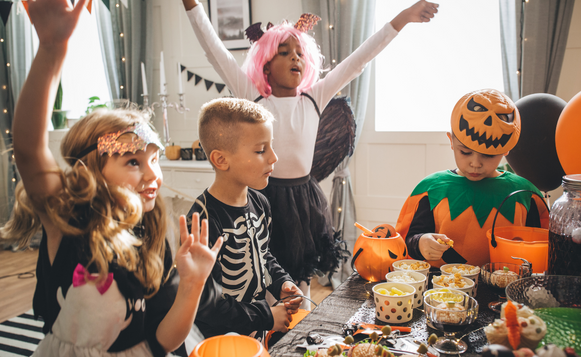Trick or treating for tasty candy, wearing eye-catching costumes, and practicing fun traditions makes Halloween an enjoyable holiday for many families. For children with autism, Halloween may lead to a change in their normal routine, heightened settings of socialization, and elevated sensory stimuli, which can be challenging for them. Loud noises, new sites, unfamiliar people, and unusual traditions may be some specific difficulties your child with autism faces during Halloween time. We have some strategies for approaching Halloween that may help manage these challenges and help make this spooky season enjoyable for your child with autism!
A lot of the strategies rely on a combination of preparation and planning, while also considering your child’s needs and emotions. In some cases, not every Halloween activity is a fit for every child. While your child may need to sit some activities out, with a wide range of activities to choose from and a little creativity, there are many ways for your child to make the most out of Halloween!

Identify and Familiarize
According to Autism Speaks, Halloween can disrupt your child’s normal routine, so making them aware of the holiday, its meaning, and the associated traditions may help them feel prepared and less overwhelmed during activities. Some ways to help identify Halloween and familiarize your child with the concept include:
- Marking the day on a calendar and counting down to Halloween.
- Using pictures or drawings to create a visual story about Halloween.
- Reading some Halloween books to model the routine of trick or treating.
- Using identification to alert candy-givers that your child may communicate differently, such as blue Halloween buckets, which are a known marker for kids with autism.
Craft Traditions to Suit Your Child & Family Needs
Not every Halloween tradition may agree with your child, which is alright! If your child has difficulties with a Halloween tradition, adaptability and creativity may make a tradition more comfortable for them. If your child is uncomfortable with the pumpkin carving process, have them use stickers or markers to decorate their pumpkin. Some other options for crafting traditions include:
- Throwing a Halloween party with family and friends familiar to your child.
- Going trick or treating earlier in the day to continue following your child’s bedtime routine.
- Planning an indoor event if your child is uncomfortable going out at night.
Prepare for Upcoming Celebrations
Some initial planning and preparation may go a long way for ensuring Halloween is fun for everyone. This preparation can extend from costume selection to trick-treating to Halloween parties. When considering Halloween traditions, identify possible challenges your child with autism may experience and plan to avoid instances that push your child’s comfort level.
- If your neighborhood’s trick-or-treating typically runs past your child’s bedtime, make sure your child gets ample sleep the night before Halloween.
- Bring food or snacks you know your child needs or likes in case the food at an event or party does not match their typical nutritional needs.
- If meeting new people overwhelms your child, plan a Halloween tradition or party involving family and friends your child is comfortable with.
- Try Halloween costumes on or have them wear a costume ahead of time to ensure a proper fit and that the costume does not cause distress for your child.
- If an event incorporates loud noises, allow your child to wear noise-reducing headphones or earbuds so they can be less overwhelmed when participating in activities.
Recognize Your Child’s Emotions
As mentioned above, Halloween activities may be overwhelming for your child, so be aware of their emotions and comfort level with each activity.
- When selecting a Halloween costume for your child, let them have a say.
- If your child is hesitant about trick-or-treating, start with only a couple of houses or only visit houses of the people your child is comfortable with.
- If wearing an entire costume causes your child distress, pivot to letting them wear a shirt and/or hat with their favorite character on it.
By considering their personal preferences, individual abilities, and sensory experiences, your child with autism may enjoy Halloween! The key is finding the balance between participating in Halloween activities and tending to your child’s needs. Even if your Halloween celebration may be a little less traditional, the important aspect is being there for your child and enjoying the moments with them. Helping Hands Family wishes you and your family have a safe and fun Halloween!
Helping Hands Family (HHF) offers autism treatment in the form of ABA Therapy that is based on each child’s unique needs. Our experienced clinic staff helps children with autism and their families throughout the Northeast. Our clinical approach is to deliver customized treatment plans to help kids with autism progress socially and support new ways of interacting with the world!





